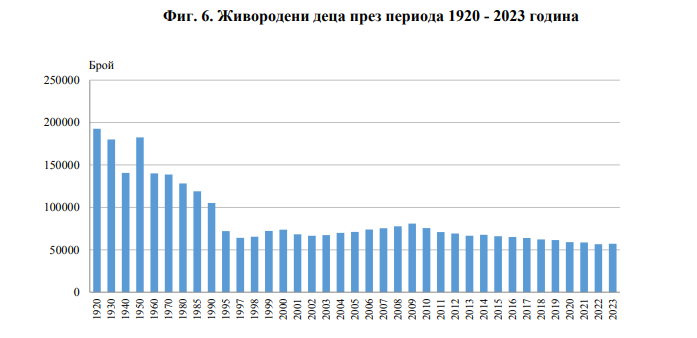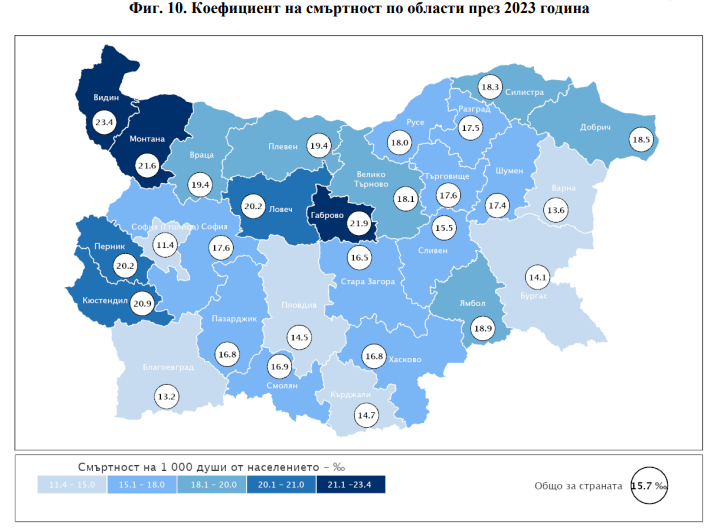The process of population decline and aging continues, although in 2023 the number of live births increases and the number of deaths decreases. This is indicated by the data of the National Statistical Institute (NSI) on the population and demographic processes, published on Monday. The statistics also show a decrease in the number of civil marriages and divorces. In 2023, as a result of negative natural growth, the country’s population decreased by 43,809 people. In 2023, all regions in the country have negative natural growth. The districts of Sofia (capital) (-1.5‰), Sliven (-3.0‰) and Blagoevgrad (-4.4‰) have the lowest coefficients of negative natural growth.
Number and structures of the population
As of December 31, 2023, the population of Bulgaria is 6,445,481 people, which represents 1.4% of the population of the European Union1. Compared to 2022, the country’s population decreases by 2,229 people, or by 0.03%. Men are 3,097,698 (48.1%), and women – 3,347,783 (51.9%), or 1,081 women per 1,000 men. The number of men predominates in the age group up to 55 years. As the age increases, the number and relative share of women in the total population of the country increases.
At the end of 2023, there are 1,530,909 people aged 65 and over, or 23.8% of the country’s population. Compared to 2022, the share of the population in this age group increased by 0.3 percentage points. In a regional aspect the share of people aged 65 and over is highest in the districts of Vidin (31.3%), Gabrovo (30.3%) and Smolyan (28.9%). In total, for the EU-27, the relative share of the population aged 65 and over is 21.3%. This share is highest in Italy (24.0%) and Portugal (24.0%). In total, in seventeen countries, including Bulgaria, the share of the elderly population is over 20.0%.
As of 31.12.2023, there are 911,025 children under the age of 15 in the country, or 14.1% of the total population. The relative share of the population under 15 years of age is highest in the districts of Sliven – 18.9%, Yambol – 15.2%, and Burgas – 14.9% of the district’s population. In total, in 17 districts this share is below the national average, the lowest being in the districts of Smolyan – 10.6%, Vidin – 11.5%, and Gabrovo – 11.7%. In 2022, the share of the youngest population in the EU-27 is 14.9%, with the lowest in Italy – 12.4%, Portugal – 12.9%, and Malta – 12.7%, and the highest in Ireland – 19.3% , Sweden – 17.4%, and France – 17.3%.
As of 31.12.2023, the total age dependency ratio2 in Bulgaria is 61.0%, or for every person in the dependent age (under 15 and over 65 years) there are less than two persons in active age. This ratio is more favorable in cities – 57.6% than in villages – 71.3%.
The population of working age as of 31.12.2023 is 3,769 thousand people, or 58.5% of the country’s population, with 1,971,000 men and 1,798,000 women. By the end of 2023, there are 1,698,000 people above working age, or 26.3%, and 977,000 people, or 15.2%, of the country’s population below working age.
Territorial distribution of the population
As of 31.12.2023, 4,738,461 people, or 73.5%, live in cities, and 1,707,020 people, or 26.5% of the country’s population, live in villages. By the end of 2023, there are 5,256 inhabited places in Bulgaria, of which 257 are cities and 4,999 are villages. There are 201 settlements without population. Their number is the largest in the regions of Veliko Tarnovo and Gabrovo – 67 each. There are six cities in the country with a population of over 100,000 people, in which 35.2% of the country’s population live.
Compared to 2022, five regions increase their population. This increase is the largest for the districts of Kardzhali and Burgas, respectively by 2.8 and 1.5%. There is a decrease in twenty-two oblasts, the largest being for the oblasts of Montana – by 1.4%, Vidin and Smolyan – by 1.3% each.
Birth rate
In 2023, 57,478 births were registered in the country, of which 57,197 (99.5%) were live births. Compared to the previous year, the number of live births increased by 601 children, or by 1.1%.
The total birth rate in 2023 is 8.9‰. The number of live births for boys (29,318) was 1,439 more than for live births for girls (27,879), or 951 girls for every 1,000 live births. There were 42,388 and 14,809 live births in the cities and villages, respectively, and the birth rate was 8.9‰ in the cities and 8.7‰ in the villages. In a regional aspect the highest birth rate is in the regions of Sliven – 12.5‰, Sofia (capital), Yambol – 9.9‰ each, and Plovdiv – 9.7‰. In 21 districts, the birth rate is lower than the national average, with the lowest values observed in the districts of Smolyan – 5.1‰, Pernik – 6.4‰, and Gabrovo – 6.8‰.

The total birth rate for the EU-27 in 2022 is 8.7‰ according to Eurostat data. The highest birth rate among EU member states is Cyprus – 11.2‰, followed by France – 10.7‰, Ireland – 10.5‰, and Sweden – 10.0‰. Italy has the lowest birth rate in the European Union – 6.7‰.
In 2023, the average age of women at birth of their first child was 27.7 years, compared to 2022 has increased by 0.1 years. In a regional aspect, the average age at birth of a first child varies from 22.2 years for the Sliven region to 30.8 years for the Sofia region (the capital).
Mortality
The number of people who died in 2023 is 101,006, and the overall mortality rate is 15.7‰. Compared to the previous year, the number of deaths decreased by 17,808, or by 15.0%. The overall mortality rate remains high. Mortality among men (16.9‰) is higher compared to mortality among women (14.5‰). In 2023, for every 1,000 women, 1,076 men die.

The death rate is higher in villages (21.0‰) than in cities (13.7‰). In a regional aspect, the regions with the highest mortality in the country are Vidin – 23.4‰, Gabrovo – 21.9‰, and Montana – 21.6‰. In eight districts, the death rate is lower than the average for the country, the lowest being in Sofia (the capital) – 11.4‰. In total, for the EU-27 the mortality rate in 2022 is 11.5‰. The level of the total mortality of the population in Bulgaria is the highest among the member states. Ireland and Luxembourg have the lowest mortality rates – 6.8‰ each, and Malta and Cyprus – 8.0‰ each. Apart from Bulgaria, the value of this indicator is higher than the EU-27 average only in Latvia – 16.4‰, Lithuania – 15.1‰, and Croatia – 14.8‰.
The rate of premature mortality in 2023 (20.1%) increases compared to the previous year 2022 (19.2%). There are differences in the values of the premature mortality indicator for men and women. Deceased women under the age of 65 are 12.5% of all deceased women, and the value of this indicator for men is 27.1%.
In 2023, 281 children under one year of age died in the country, and the infant mortality rate was 4.9‰. For comparison, in 2002 the infant mortality rate was 13.3‰, and in 2022 – 4.8‰. In a regional aspect, in 2023, in a total of 13 districts, the infant mortality rate is lower than the average for the country, the lowest being in the districts of Kyustendil – 1.3‰, Gabrovo – 1.5‰, and Veliko Tarnovo – 1.9‰. The highest value of the child mortality rate was registered in the regions of Razgrad (12.8‰), Sliven (10.8‰) and Stara Zagora (8.6‰).
Marriages and divorces
In 2023, 21,800 legal marriages were registered – 4,213 less than the previous year, and the marriage rate was 3.4‰. Nearly three-quarters of all registered marriages (16,105) are among the urban population. In 2023 the average age at first marriage for men and women is 33.4 and 30.3 years, respectively. Compared to the previous year, the average age increased by 0.4 years for men and 0.2 for women. For 84.6% of women and 84.2% of men, the civil marriage concluded in 2023 was the first. The regions with the most marriages per 1,000 of the population are Sofia (the capital) – 4.1‰, and Razgrad – 3.9‰, and the lowest marriage rate is in Pernik district – 2.4‰. The number of divorces in 2023 was 9,088, or 437 fewer than those registered in 2022. Of all terminated marriages, 77.6% refer to the urban population.
Migration
In 2023, 107,836 people moved between settlements in the country.
In 2023 15,227 people have changed their current address from the country abroadwith 60.9% of them being men. The most preferred destinations by emigrants are Germany (18.1%), the United Kingdom (16.9%) and France (8.4%). In 2023, 56,807 persons changed their habitual residence from abroad to Bulgaria. The relative share of men is 53.7%, and of women – 46.3%.
Among those who came to live in the country, 14.1% are in the age group 0 – 14 years, 73.1% are 15 – 64 years old, and 12.8% of immigrants are 65 and over. The share of immigrants from Turkey (25.0%), Ukraine (17.5%) and Russian Federation (9.7%).
#population #continues #decline #age







